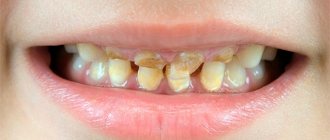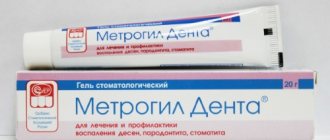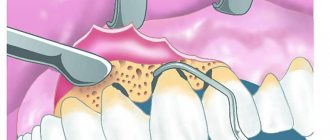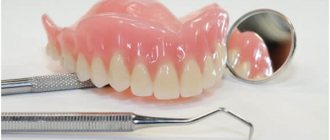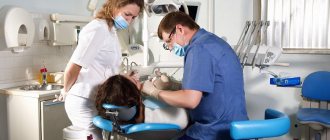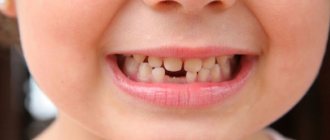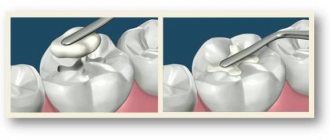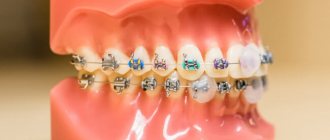The condition when a child is growing a tooth, but the baby tooth has not yet fallen out, is also called “shark teeth” - the primary and molar teeth are located in two rows, which resembles the bite of this marine predator.
But is this always a problem that requires surgical removal of “old” teeth, or can we wait for the situation to resolve itself? Therefore, we will next consider what to do if a permanent tooth grows behind a milk tooth!
Causes
In most cases, when a permanent tooth grows behind a milk tooth, the problem develops due to insufficient chewing load on the teeth. Today, the average child’s diet can be described as refined!
The main part of the daily diet consists of thermally or mechanically processed food, which does not require the child to make efforts to grind it with his teeth.
Parents often believe that by eating this way they are, on the contrary, taking care of their baby’s teeth, and this will allow them to remain healthy for as long as possible. But chewing is a natural and very important function that ensures the health of the entire dental system.
While chewing food, pressure is exerted on the periodontium - the musculoskeletal system of the teeth, stimulating blood circulation and the supply of nutrients. Without this, the growth of baby teeth may be disrupted and their abnormal replacement by permanent ones may develop.
A more rare reason that a child has double rows of teeth is scarring of the gums in the area of the baby teeth. This may be a consequence of mechanical injury, thermal or chemical burn.
In this case, the connective tissue, which is a scar, begins to play the role of an additional “ligament” that firmly holds the tooth in the gum.
When teeth start to loosen and fall out
Interestingly, the makings of teeth are formed in the womb in the second or third month of pregnancy. The first teeth erupting in a baby can be noticed already by six months. Read more about when and in what order children’s first teeth appear here.
By the age of five, when the set is already fully formed and numbers twenty pieces, the distance between the teeth begins to expand, and the first molars erupt in the empty spaces. Then the baby teeth begin to loosen and fall out, and new permanent teeth appear in their place.
Possible complications
Teeth growth, even when it proceeds normally, is a rather painful and unpleasant process. It is even more uncomfortable when it is broken. In a child, “double” teeth negatively affect articulation, and if this continues for a long time, incorrect diction can become permanent.
In addition, in children with impaired chewing (and this is what discomfort due to abnormal positioning of teeth leads to), aerophagia is often observed - swallowing a large amount of air along with food.
The child, not being able to chew food normally, simply swallows it in large pieces, and with it, air. The result of this can be dyspepsia, flatulence, and even underweight - the air in the stomach creates the illusion of fullness, and the child is regularly malnourished.
Among dental complications, the most common is an increased risk of caries. When a child grows a tooth next to a baby tooth, this greatly complicates the quality of teeth cleaning, and a constant accumulation of plaque and bacteria forms between temporary and permanent teeth.
Therefore, often a delay in seeing a doctor leads to the fact that, having removed a baby tooth, the doctor sees an active and already pronounced carious process on the root (milk caries).
Typical causes of loose molars in children
- In the process of natural replacement of temporary teeth with permanent ones, mobile, restless children often injure their faces. A strong blow to the jaw can damage the surrounding soft tissues and lead to dislocation and fracture of the tooth. The damaged tooth will become mobile.
- In children, during a change in bite, inflammatory processes often occur in the oral cavity - in particular, gingivitis, inflammation of the gums.
- Only erupted molars are particularly susceptible to acid-forming bacteria. Quite often, carious cavities form in places that are difficult to access and are detected only when the child’s molar is already loose.
- Recently, children often have weak, loose gums. If hygiene is insufficient, they are easily affected by pathogenic bacteria and become inflamed. Periodontitis that occurs in children leads to loosening of teeth.
- The cause of the problem can also be diseases of internal organs caused by pathological metabolic processes and impaired blood supply.
- The genetic factor also plays a certain role. Cases of premature loss of healthy teeth that often occur in families may indicate an inherited predisposition to insufficient fixation of dental roots in bone tissue.
Factors such as poor nutrition, decreased immunity, abnormal bite, bruxism, and, during puberty, hormonal changes also increase risks.
When to see a doctor?
It is generally accepted that the “paired” arrangement of teeth can be normal if this lasts no more than 2-3 months. After a baby tooth falls out, the molar gradually changes its position and after a few months takes the correct position.
Watch the video:
Therefore, if a new tooth has just begun to grow, and the old one is still firmly in the gum, you can simply monitor the situation for several weeks and monitor the quality of oral hygiene.
But in some cases, you cannot hesitate to see a doctor. Be sure to make an appointment with your pediatric dentist if you experience one or more of the following symptoms:
- The child complains of pain and severe discomfort in the mouth, or you see some signs that this arrangement of the teeth greatly interferes with him (he began to eat poorly, “chokes” while eating, etc.).
- The baby tooth has not started to loosen over time and sits very firmly in the gum.
- The child's mouth has an unpleasant odor.
- The child has a predisposition to malocclusions or dental deformations (he has already been treated for temporary occlusion disorders, one of the parents had impaired tooth growth or their location in the dentition).
The listed circumstances may indicate the occurrence of dental problems that require immediate treatment.
Rules that will ensure safety
When removing a tooth at home, it is necessary to exercise maximum caution, since incorrect actions or insufficient cleanliness of hands and equipment for the procedure will harm the little patient. It is recommended to adhere to the following rules:
- Manipulation is carried out only when the baby tooth is very loose.
- Before removing a loose tooth, you should give the child something to eat, since after pulling out it is necessary to limit food intake for a certain period of time.
- For manual removal, it is recommended to place a small piece of gauze on the tooth and wear disposable gloves.
- The thread used to pull out the milk unit should be treated with an antiseptic. Alcohol and Chlorhexidine are suitable for this purpose. The tooth must be dried with sterile cotton wool or a bandage.
- Before starting the manipulation, an adult needs to thoroughly treat their hands with a disinfectant. The child should brush his teeth well to prevent food debris from getting into the wound.
- If the tooth cannot be easily removed, it is necessary to postpone the procedure for 2-3 days. In order for the next attempt to be successful, the baby should loosen the tooth with his tongue so that it freely deviates back and forth.
- The manipulation is not carried out when the patient cries and breaks out.
- You can feed and water your child 3–4 hours after removal. It is necessary to maintain the gap so that a crust appears at the site of the formed hole, protecting the wound from infection.
- As soon as the tooth is removed, you need to place a small piece of cotton wool moistened with alcohol or another antibacterial agent on the wound (we recommend reading: how long should you keep the cotton wool after tooth extraction?). The cotton wool should be kept for 15 – 20 minutes.
Read also: Wound after wisdom tooth removal
To prevent complications after home surgery, you should avoid eating hot or very cold foods for the next few days. Drinks and foods at low and high temperatures can cause bleeding or pain. Reduce the consumption of sweets, since sugar is a stimulator of the development of pathogenic microflora.
The little patient should not be overheated for 2 days. A hot bath causes blood vessels to dilate, which leads to bleeding.
On day 3, you should start rinsing with antiseptic agents. Rinse the mouth with a diluted solution of Chlorhexidine, chamomile decoction, Chlorphyllipt with water, a solution of salt and water with the addition of iodine. Rinsing should be done daily after meals for 5 to 7 days.
After tooth extraction, you should brush your teeth only with a soft brush. The child needs to be explained that the injury site should not be pressed too hard. The video presents methods for removing a tooth at home, describes precautions and rules of behavior after the manipulation.
Treatment methods
If a molar grows in front of or behind a baby tooth, the doctor decides what to do in this situation only after a personal examination. To choose the right treatment tactics, the age of the child is important, how firmly the baby tooth is fixed in the gums and how much the molar has already grown, whether the child has other dental anomalies or diseases that could be the source of this problem, etc.
Based on the results of the examination, a decision may be made to remove the baby tooth or to continue observation. We recommend that you learn more about the removal of baby teeth here:
Removal of a baby tooth in a child: indications, consequences
In the first case, the child is given local or mask anesthesia and the baby tooth is extracted. After this, a visit to the doctor is scheduled at a certain frequency - it is important to monitor the dynamics of the movement of the permanent tooth into the dentition, and if this process is not observed or it is too slow, orthodontic treatment may be required.
In non-advanced cases, it is usually sufficient to wear a trainer selected according to the individual parameters of the child’s dental system. This device creates the necessary tension in the teeth, which “forces” them to move into the desired position.
A child’s baby teeth are loose, what to do?
If a child’s baby tooth is loose, this is both joy and sorrow. Joy for parents - the child is growing up! And woe for the child for whom this situation does not bring pleasure, especially when mom and dad begin to heatedly discuss ways to pull him out, especially emphasizing the classic method - with a door and a thread. Other parents, at the first available free time, take their child to the dentist, and for most children, this outcome also seems undesirable. Both solutions are actually extremes. It’s better when they loosen on their own, unless of course they are molars.
Removed milk tooth on a string
Prevention of abnormal tooth growth
To prevent dental growth abnormalities, it is important to follow a few simple recommendations:
- A child's diet should always include fresh and tough vegetables and fruits that require active and prolonged chewing.
- For any gum injuries, it is important to consult a doctor and receive treatment that reduces the likelihood of scarring and tissue hyperplasia.
- It is important to adhere to age norms regarding bottle feeding. Already at the age of 1 year, he should try to eat from a spoon and drink from a cup himself or do this with the help of his parents, and the number of bottle feedings should gradually be reduced to zero.
If you identify any complaints, symptoms, anomalies or abnormalities, promptly contact your dentist to stop the development of complications.
Loose tooth: to pull out or not
First of all, it is important to tell your child about the process of changing teeth so that he is not afraid and it does not come as a surprise to him. Tell them that in place of the lost tooth a new, stronger and more beautiful one will grow. Be sure to explain that a lost tooth cannot be swallowed!
To speed up, gently and slightly loosen with your fingers, but only with clean hands! In addition, the baby can loosen the tooth with his tongue in his mouth. In addition, you can use light pulling methods, which are often used by parents. Be sure to maintain cleanliness and sterility!
Before the procedure, wash your hands thoroughly, and let your child brush his teeth and rinse his mouth to remove any remaining food. Take a sterile bandage and grab the tooth. Pull it up and then rotate it around its axis, and then it will easily come out on its own. You can also use the old method of thread plucking.
After the procedure, you need to rinse your mouth with a decoction of calendula or chamomile, a solution of soda or potassium permanganate, or a special antiseptic composition. If the wound is bleeding, apply a cotton swab soaked in diluted potassium permanganate to the problem area.

